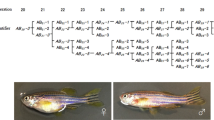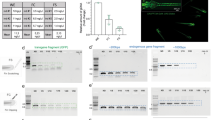Abstract
Poorly controlled background genetics in animal models contributes to the lack of reproducibility that is increasingly recognized in biomedical research. The laboratory zebrafish, Danio rerio, has been an important model organism for decades in many research areas, yet inbred strains and traditionally managed outbred stocks are not available for this species. Sometimes incorrectly referred to as ‘inbred strains’ or ‘strains’, zebrafish wild-type lines possess background genetics that are often not well characterized, and breeding practices for these lines have not been consistent over time or among institutions. In this Perspective, we trace key milestones in the history of one of the most widely used genetic backgrounds, the AB line, to illustrate the dynamic complexity within an example background that is largely invisible when reading the scientific literature. Failure to adequately control for genetic background compromises the validity of experimental outcomes. We therefore propose that authors provide as much specific detail about the origin and genetic makeup of zebrafish lines as is reasonable and possible, and that the terms used to describe background genetics be applied in a way that is consistent with other fish and mammalian model organisms. We strongly encourage the adoption of genetic monitoring for the characterization of existing zebrafish lines, to help detect genetic contamination in breeding colonies and to verify the level of genetic heterogeneity in breeding colonies over time. Careful attention to background genetics will improve transparency and reproducibility, therefore improving the utility of the zebrafish as a model organism.
This is a preview of subscription content, access via your institution
Access options
Subscribe to this journal
We are sorry, but there is no personal subscription option available for your country.
Buy this article
- Purchase on Springer Link
- Instant access to full article PDF
Prices may be subject to local taxes which are calculated during checkout

Similar content being viewed by others
References
Franklin, C. L. & Ericsson, A. C. Microbiota and reproducibility of rodent models. Lab Anim. (NY) 46, 114–122 (2017).
Chan, J. C., Houghton, A. B. & Bale, T. L. Strained in planning your mouse background? Using the HPA stress axis as a biological readout for backcrossing strategies. Neuropsychopharmacology 42, 1749–1751 (2017).
Carter, T. et al. Standardized nomenclature for inbred strains of mice: prepared by the Committee on Standardized Nomenclature for Inbred Strains of Mice. Cancer Res. 12, 602–613 (1952).
Green, M. C. in Handbook of Genetics Vol. 4 (ed. King, R. C.) 203–241 (Plenum Press, 1975).
Whary, M. T., Baumgarth, N., Fox, J. G. & Barthold, S. W. in Laboratory Animal Medicine 3rd edn (eds Fox, J. G. et al.) 43–149 (Academic Press, 2015).
Eppig, J. T. in The Mouse in Biomedical Research 2nd edn, Vol. 1 (eds Fox, J. G. et al.) 79–98 (Elsevier, 2007).
Festing, M. F. W. in Encyclopedia of Immunology 2nd edn, Vol. 3 (eds Delves, P. J. & Roitt, I. M.) 1369–1372 (Academic Press, 1998).
Franěk, R. et al. Isogenic lines in fish–a critical review. Rev. Aquac. 12, 1412–1434 (2020).
Sundberg, J. P. & Schofield, P. N. Commentary: mouse genetic nomenclature. Standardization of strain, gene, and protein symbols. Vet. Pathol. 47, 1100–1104 (2010).
Mandillo, S. et al. Reliability, robustness, and reproducibility in mouse behavioral phenotyping: a cross-laboratory study. Physiol. Genomics 34, 243–255 (2008).
Montkowski, A., Poettig, M., Mederer, A. & Holsboer, F. Behavioural performance in three substrains of mouse strain 129. Brain Res. 762, 12–18 (1997).
Simon, M. M. et al. A comparative phenotypic and genomic analysis of C57BL/6J and C57BL/6N mouse strains. Genome Biol. 14, R82 (2013).
Spivakov, M. et al. Genomic and phenotypic characterization of a wild medaka population: towards the establishment of an isogenic population genetic resource in fish. G3 (Bethesda) 4, 433–445 (2014).
Kirchmaier, S., Naruse, K., Wittbrodt, J. & Loosli, F. The genomic and genetic toolbox of the teleost medaka (Oryzias latipes). Genetics 199, 905–918 (2015).
Hyodo-Taguchi, Y. Inbred strains of the medaka, Oryzias latipes. Fish Biol. J. MEDAKA 8, 11–14 (1996).
Angus, R. A. & Schultz, J. Clonal diversity in the unisexual fish Poeciliopsis monacha-lucida: a tissue graft analysis. Evolution 33, 27–40 (1979).
Schultz, M. E. & Schultz, R. J. Differences in response to a chemical carcinogen within species and clones of the livebearing fish, Poeciliopsis. Carcinogenesis 9, 1029–1032 (1988).
Vrijenhoek, R. C., Angus, R. A. & Schultz, R. J. Variation and heterozygosity in sexually vs. clonally reproducing populations of Poeciliopsis. Evolution 31, 767–781 (1977).
Shen, Y. et al. X. couchianus and X. hellerii genome models provide genomic variation insight among Xiphophorus species. BMC Genomics 17, 37 (2016).
Walter, R. B., Hazlewood, L., Kazianis, S., Kallman, K. & Schartl, M. The Xiphophorus genetic stock center manual. (San Marcos, Texas State University; accessed 27 May 2020).
Meyer, B. M., Froehlich, J. M., Galt, N. J. & Biga, P. R. Inbred strains of zebrafish exhibit variation in growth performance and myostatin expression following fasting. Comp. Biochem. Physiol. A Mol. Integr. Physiol. 164, 1–9 (2013).
Volgin, A. D. et al. Zebrafish models for personalized psychiatry: insights from individual, strain and sex differences, and modeling gene x environment interactions. J. Neurosci. Res. 97, 402–413 (2019).
Gorissen, M. et al. Differences in inhibitory avoidance, cortisol and brain gene expression in TL and AB zebrafish. Genes Brain Behav. 14, 428–438 (2015).
Liu, X. et al. Strain-dependent differential behavioral responses of zebrafish larvae to acute MK-801 treatment. Pharmacol. Biochem. Behav. 127, 82–89 (2014).
Mahabir, S., Chatterjee, D. & Gerlai, R. Short exposure to low concentrations of alcohol during embryonic development has only subtle and strain-dependent effect on the levels of five amino acid neurotransmitters in zebrafish. Neurotoxicol. Teratol. 68, 91–96 (2018).
van den Bos, R. et al. Early life exposure to cortisol in zebrafish (Danio rerio): similarities and differences in behaviour and physiology between larvae of the AB and TL strains. Behav. Pharmacol. 30, 260–271 (2019).
Wakamatsu, Y., Ogino, K. & Hirata, H. Swimming capability of zebrafish is governed by water temperature, caudal fin length and genetic background. Sci. Rep. 9, 16307 (2019).
van den Bos, R., Flik, G. & Gorissen, M. in Behavioral and Neural Genetics of Zebrafish (ed. Gerlai, R.) 245–262 (Elsevier, 2020).
Audira, G., Siregar, P., Strungaru, S. A., Huang, J. C. & Hsiao, C. D. Which zebrafish strains are more suitable to perform behavioral studies? A comprehensive comparison by phenomic approach. Biology (Basel) 9, 200 (2020).
Siregar, P. et al. Method standardization for conducting innate color preference studies in different zebrafish strains. Biomedicines 8, 271 (2020).
Chapman, F. A., Fitz‐Coy, S. A., Thunberg, E. M. & Adams, C. M. United States of America trade in ornamental fish. J. World Aquac. Soc. 28, 1–10 (1997).
Freeman, A. et al. in The Biological Resources of Model Organisms: Collection, Characterization and Applications (eds Jarret, R. L. & McCluskey, K.) 108–139 (CRC Press, 2019).
Solnica-Krezel, L., Schier, A. F. & Driever, W. Efficient recovery of ENU-induced mutations from the zebrafish germline. Genetics 136, 1401–1420 (1994).
Brockerhoff, S. E. et al. A behavioral screen for isolating zebrafish mutants with visual system defects. Proc. Natl Acad. Sci. USA 92, 10545–10549 (1995).
Lawrence, C. Advances in zebrafish husbandry and management. Methods Cell Biol. 104, 429–451 (2011).
Kimura, M. & Crow, J. F. On the maximum avoidance of inbreeding. Genet. Res. (Camb.) 4, 399–415 (1963).
Streisinger, G., Walker, C., Dower, N., Knauber, D. & Singer, F. Production of clones of homozygous diploid zebra fish (Brachydanio rerio). Nature 291, 293–296 (1981).
Johnson, S. L., Africa, D., Horne, S. & Postlethwait, J. H. Half-tetrad analysis in zebrafish: mapping the ros mutation and the centromere of linkage group I. Genetics 139, 1727–1735 (1995).
Mizgirev, I. & Revskoy, S. Generation of clonal zebrafish lines and transplantable hepatic tumors. Nat. Protoc. 5, 383–394 (2010).
Nechiporuk, A., Finney, J. E., Keating, M. T. & Johnson, S. L. Assessment of polymorphism in zebrafish mapping strains. Genome Res. 9, 1231–1238 (1999).
Shinya, M. & Sakai, N. Generation of highly homogeneous strains of zebrafish through full sib-pair mating. G3 (Bethesda) 1, 377–386 (2011).
Trevarrow, B. & Robison, B. Genetic backgrounds, standard lines, and husbandry of zebrafish. Methods Cell Biol. 77, 599–616 (2004).
Westerfield, M. The Zebrafish Book: A Guide for the Laboratory Use of Zebrafish Danio ("Brachydanio rerio") 5th edn (University of Oregon Press, 2007).
Nasiadka, A. & Clark, M. D. Zebrafish breeding in the laboratory environment. ILAR J. 53, 161–168 (2012).
LaFave, M. C., Varshney, G. K., Vemulapalli, M., Mullikin, J. C. & Burgess, S. M. A defined zebrafish line for high-throughput genetics and genomics: NHGRI-1. Genetics 198, 167–170 (2014).
Balik-Meisner, M., Truong, L., Scholl, E. H., Tanguay, R. L. & Reif, D. M. Population genetic diversity in zebrafish lines. Mamm. Genome 29, 90–100 (2018).
Kent, M. L. et al. Development and maintenance of a specific pathogen-free (SPF) zebrafish research facility for Pseudoloma neurophilia. Dis. Aquat. Organ. 95, 73–79 (2011).
Almeida, J. L. et al. Interlaboratory study to validate a STR profiling method for intraspecies identification of mouse cell lines. PLoS ONE 14, e0218412 (2019).
Benavides, F. et al. Genetic quality assurance and genetic monitoring of laboratory mice and rats: FELASA Working Group Report. Lab. Anim. 54, 135–148 (2020).
Bryda, E. C. & Riley, L. K. Multiplex microsatellite marker panels for genetic monitoring of common rat strains. J. Am. Assoc. Lab. Anim. Sci. 47, 37–41 (2008).
Guénet, J.-L. & Benavides, F. J. in Molecular Diagnostics 2nd edn (eds Patrinos, G. P. & Ansorge, W.) 461–469 (Elsevier, 2010).
Fahey, J. R., Katoh, H., Malcolm, R. & Perez, A. V. The case for genetic monitoring of mice and rats used in biomedical research. Mamm. Genome 24, 89–94 (2013).
Fox, R. R., Wiles, M. V. & Petkov, P. M. in The Mouse in Biomedical Research 2nd edn, Vol. 1 (eds Fox, J. G. et al.) 135–144 (Academic Press, 2007).
Butler, M. G. et al. SNPfisher: tools for probing genetic variation in laboratory-reared zebrafish. Development 142, 1542–1552 (2015).
Obholzer, N. et al. Rapid positional cloning of zebrafish mutations by linkage and homozygosity mapping using whole-genome sequencing. Development 139, 4280–4290 (2012).
Shimoda, N. et al. Zebrafish genetic map with 2000 microsatellite markers. Genomics 58, 219–232 (1999).
Whiteley, A. R. et al. Population genomics of wild and laboratory zebrafish (Danio rerio). Mol. Ecol. 20, 4259–4276 (2011).
Coe, T. S. et al. Genetic variation in strains of zebrafish (Danio rerio) and the implications for ecotoxicology studies. Ecotoxicology 18, 144–150 (2009).
Venta, P. J. et al. A 13-plex of tetra- and penta-STRs to identify zebrafish. Sci. Rep. 10, 3851 (2020).
Festing, M., Kondo, K., Loosli, R., Poiley, S. M. & Spiegel, A. International standardized nomenclature for outbred stocks of laboratory animals. Z. Versuchstierkd. 14, 215–224 (1972).
Chia, R., Achilli, F., Festing, M. F. & Fisher, E. M. The origins and uses of mouse outbred stocks. Nat. Genet. 37, 1181–1186 (2005).
Lohmiller, J. J., Swing, S. P. & Hanson, M. M. in The Laboratory Rat 3rd edn (eds Suckow, M. A. et al.) 157–179 (Elsevier, 2020).
Percie du Sert, N. et al. The ARRIVE guidelines 2.0: updated guidelines for reporting animal research. J. Cereb. Blood Flow Metab. 40, 1769–1777 (2020).
Author information
Authors and Affiliations
Contributions
Both authors contributed equally to this work.
Corresponding authors
Ethics declarations
Competing interests
The authors declare no competing interests.
Additional information
Publisher’s note Springer Nature remains neutral with regard to jurisdictional claims in published maps and institutional affiliations.
Rights and permissions
About this article
Cite this article
Crim, M.J., Lawrence, C. A fish is not a mouse: understanding differences in background genetics is critical for reproducibility. Lab Anim 50, 19–25 (2021). https://doi.org/10.1038/s41684-020-00683-x
Received:
Accepted:
Published:
Issue Date:
DOI: https://doi.org/10.1038/s41684-020-00683-x
This article is cited by
-
On the value of zebrafish outbred strains in neurobehavioral research
Lab Animal (2022)
-
The phylogenetic position of zebrafish (Danio rerio) from south african pet shops
Molecular Biology Reports (2022)
-
CRISPR-Cas9 F0 knockout approach using predesigned in vitro transcribed guide RNAs partially recapitulates Rx3 function in eye morphogenesis
Journal of Genetics (2022)
-
Molecular and culture-based assessment of the microbiome in a zebrafish (Danio rerio) housing system during set-up and equilibration
Animal Microbiome (2021)



